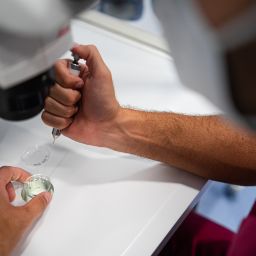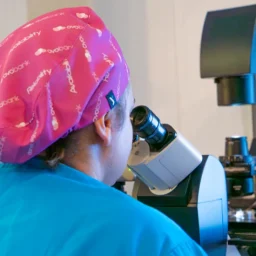
Foetal health is one of the main concerns of prospective parents using different assisted reproduction (AR) programmes. As these techniques have advanced, so has interest in understanding their impact on embryo development and the long-term health of the baby. Ensuring a safe pregnancy depends not only on the successful implantation of the embryo, but also on the quality of the gametes, the uterine environment and the proper development of the foetus. In this context, the possible link between AR and the risk of congenital anomalies, such as heart disease, has been the subject of numerous scientific studies. Therefore, on the occasion of International Congenital Heart Disease Day, we are going to find out whether or not there is a real risk of these conditions in births through assisted reproduction techniques.
What do we know about congenital heart disease?
Congenital heart defects (CHD) are structural abnormalities of the heart and intrathoracic vessels. These abnormalities occur during pregnancy or at birth. Among congenital anomalies, cardiac anomalies account for approximately 50% of all severe congenital anomalies, affecting between 1%-2% of children in the general population.
Although many congenital heart defects are recorded at birth and some later in life, the true incidence of congenital heart disease remains largely unknown due to under-identification in pregnancies that end in miscarriage, termination of pregnancy or stillbirth. Congenital heart disease is a major paediatric health problem and remains the leading cause of mortality from congenital defects.
Congenital heart disease (CHD) is a major cause of perinatal mortality. According to the EUROCAT registry (European network of population-based registries for the epidemiological surveillance of congenital anomalies), congenital heart disease occurs in 0.76% of live births and 0.61% if underlying genetic diseases are excluded. However, some studies report an incidence of up to 1.5%, especially if all cases of intrauterine foetal death (IUFD), termination of pregnancy (IUFD) and stillbirths are taken into account. The inclusion of early spontaneous miscarriages gives an idea of this incidence, but they are almost impossible to record.
Tetralogy of Fallot: one of the most frequent heart diseases
Among congenital heart diseases, Tetralogy of Fallot is one of the most common conditions. It is a congenital heart defect in which a baby born with this condition has well-defined heart problems. These problems affect the structure of the heart. A condition that alters the heart’s blood flow and can also affect blood flow in other organs and tissues. Babies with Tetralogy of Fallot may have a bluish or greyish skin colour due to low oxygen levels. Tetralogy of Fallot is usually diagnosed during pregnancy or shortly after the baby is born. If the heart changes and symptoms are mild, Tetralogy of Fallot may not be noticed or diagnosed until adulthood. People diagnosed with Tetralogy of Fallot may not be noticed or diagnosed until adulthood. diagnosed with Tetralogy of Fallot require heart surgery as well as regular medical check-ups throughout life.
The exact cause of this congenital condition is unknown. Some of the causes that may increase the risk of a baby being born with Tetralogy of Fallot include the following:
- Family history
- Having a viral infection during pregnancy (such as rubella).
- Alcohol consumption during pregnancy
- Poor diet during pregnancy
- Smoking during pregnancy
- Mother’s age over 35 years
- Down’s syndrome or DiGeorge’s syndrome (22q11.2 deletion syndrome) in the baby
Scientific evidence: is there a significant risk in assisted reproduction techniques?
Several studies including systematic reviews as well as cohort studies have found an increased risk of congenital heart disease in children born by Assisted Reproductive Technologies.
The study by Giorgione et al. on the risk of suffering from a type of congenital heart disease (Tetralogy of Fallot, TOF) in children conceived by ART included a review of 8 selected studies that allowed the risk of suffering from this pathology in newborns born by assisted reproduction techniques to be analysed. Specifically, in 25,856 children conceived by ART compared to 287,995 children conceived naturally, derived from both single and multiple gestations. These authors observed an incidence of 1.30% of this type of heart disease in children conceived by assisted reproduction techniques compared to 0.68% in children conceived naturally.
The recent study published in the European Heart Journal (2024) has revealed that babies born using assisted reproductive techniques have a higher risk of developing serious heart defects compared to those conceived naturally. The analysis included more than 7.7 million live births in Denmark, Finland, Norway and Sweden. It found that 1.84% of babies born by ART were diagnosed with major heart defects compared to 1.15% in those born spontaneously. In addition, the study highlighted that the risk is particularly high in multiple births, which are more common in ART pregnancies. Although the increased risk is significant, the authors note that the absolute risk remains low, at 1.84% in ART births compared to 1.15% in natural births.
Congenital heart disease is a serious but rare disease. These studies show, specifically the large study published by the European Heart Journal in 2024, that there is a higher incidence of congenital heart disease after conception with Assisted Reproduction Techniques. But they are conclusive in pointing out that these rates are higher in children born from multiple pregnancies, which are more frequent in Assisted Reproduction Techniques.
These studies observed no differences between ICSI and conventional IVF, nor between children born after fresh transfer or delayed transfer (cryotransfer).
These studies show that, although the risk of severe ischaemic heart disease is higher in children born from an Assisted Reproductive Technology, the absolute increase in risk is not high. They also conclude on the importance of the transfer of a single embryo, in Assisted Reproduction Techniques, in order to avoid the increased risk of multiple pregnancy.






